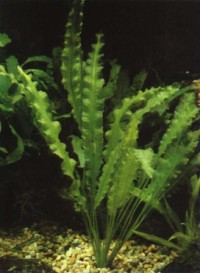Aponogeton crispus
| Aponogeton crispus | |
|---|---|
 |
|
| Foliage | |
| Scientific classification | |
| Kingdom: | Plantae |
| (unranked): | Angiosperms |
| (unranked): | Monocots |
| Order: | Alismatales |
| Family: | Aponogetonaceae |
| Genus: | Aponogeton |
| Species: | A. crispus |
| Binomial name | |
|
Aponogeton crispus Thunberg (1781) |
|
Aponogeton crispus is an aquatic plant species.
Ruffled / Crinkled or Wavy-edged Aponogeton; Kekatiya in Sri Lanka.
Native to southern India and Sri Lanka, where it usually occurs in seasonal ponds, becoming dormant in the dry season,Aponogeton crispus is found naturally in both still and running waters.
It is a seasonally submerged aquatic plant with a round rhizome 2–3 cm and up to 5 cm in diameter. The leaves are light green to olive green-brown, 8 – 14 inches (20–35 cm) long and 2.5 inches (6 cm) broad, with a wavy margin and a petiole up to 18 inches (45 cm) long; wild plants tend to have longer and narrower leaves than the cultivated varieties. No floating leaves are formed. The flowers are produced on an erect stem up to 80 cm tall with an apical white (- pink) spike-like raceme up to 18 cm long; each flower is small, with a 2 mm perianth and six stamens. The flowers are scented, and a flowering spike will last 1 – 2 weeks. The seeds are elliptical, 5–6 mm long and 2 mm diameter.
Many plants sold in the aquarium trade are actually hybrids and many are sterile. The genuine plant never has leaves that float on the surface of the water.
It is a protected plant in Sri Lanka, where A. crispus is banned from exportation under Section 24 (1) of Forest Ordinance.
Aponogeton crispus is often cultivated as an aquarium plant and is probably the easiest and most robust of the aponogetons. It requires a mineral-rich substrate where carbon dioxide is easily available in the form of carbonic acid.
...
Wikipedia
